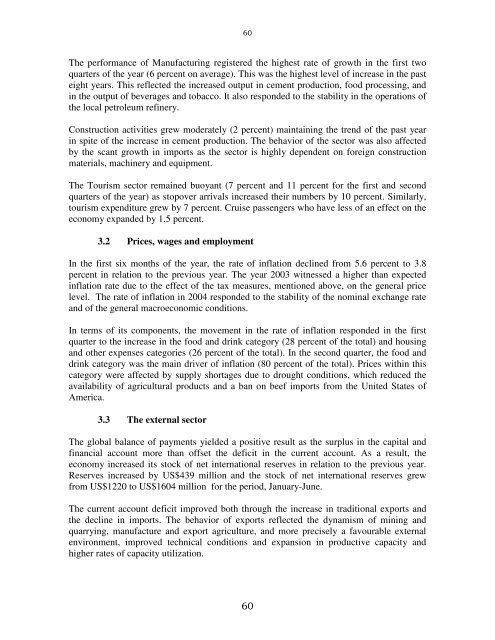Jamaica: Macro-Socio-Economic and Environmental Assessment of ...
Jamaica: Macro-Socio-Economic and Environmental Assessment of ...
Jamaica: Macro-Socio-Economic and Environmental Assessment of ...
Create successful ePaper yourself
Turn your PDF publications into a flip-book with our unique Google optimized e-Paper software.
60<br />
The performance <strong>of</strong> Manufacturing registered the highest rate <strong>of</strong> growth in the first two<br />
quarters <strong>of</strong> the year (6 percent on average). This was the highest level <strong>of</strong> increase in the past<br />
eight years. This reflected the increased output in cement production, food processing, <strong>and</strong><br />
in the output <strong>of</strong> beverages <strong>and</strong> tobacco. It also responded to the stability in the operations <strong>of</strong><br />
the local petroleum refinery.<br />
Construction activities grew moderately (2 percent) maintaining the trend <strong>of</strong> the past year<br />
in spite <strong>of</strong> the increase in cement production. The behavior <strong>of</strong> the sector was also affected<br />
by the scant growth in imports as the sector is highly dependent on foreign construction<br />
materials, machinery <strong>and</strong> equipment.<br />
The Tourism sector remained buoyant (7 percent <strong>and</strong> 11 percent for the first <strong>and</strong> second<br />
quarters <strong>of</strong> the year) as stopover arrivals increased their numbers by 10 percent. Similarly,<br />
tourism expenditure grew by 7 percent. Cruise passengers who have less <strong>of</strong> an effect on the<br />
economy exp<strong>and</strong>ed by 1.5 percent.<br />
3.2 Prices, wages <strong>and</strong> employment<br />
In the first six months <strong>of</strong> the year, the rate <strong>of</strong> inflation declined from 5.6 percent to 3.8<br />
percent in relation to the previous year. The year 2003 witnessed a higher than expected<br />
inflation rate due to the effect <strong>of</strong> the tax measures, mentioned above, on the general price<br />
level. The rate <strong>of</strong> inflation in 2004 responded to the stability <strong>of</strong> the nominal exchange rate<br />
<strong>and</strong> <strong>of</strong> the general macroeconomic conditions.<br />
In terms <strong>of</strong> its components, the movement in the rate <strong>of</strong> inflation responded in the first<br />
quarter to the increase in the food <strong>and</strong> drink category (28 percent <strong>of</strong> the total) <strong>and</strong> housing<br />
<strong>and</strong> other expenses categories (26 percent <strong>of</strong> the total). In the second quarter, the food <strong>and</strong><br />
drink category was the main driver <strong>of</strong> inflation (80 percent <strong>of</strong> the total). Prices within this<br />
category were affected by supply shortages due to drought conditions, which reduced the<br />
availability <strong>of</strong> agricultural products <strong>and</strong> a ban on beef imports from the United States <strong>of</strong><br />
America.<br />
3.3 The external sector<br />
The global balance <strong>of</strong> payments yielded a positive result as the surplus in the capital <strong>and</strong><br />
financial account more than <strong>of</strong>fset the deficit in the current account. As a result, the<br />
economy increased its stock <strong>of</strong> net international reserves in relation to the previous year.<br />
Reserves increased by US$439 million <strong>and</strong> the stock <strong>of</strong> net international reserves grew<br />
from US$1220 to US$1604 million for the period, January-June.<br />
The current account deficit improved both through the increase in traditional exports <strong>and</strong><br />
the decline in imports. The behavior <strong>of</strong> exports reflected the dynamism <strong>of</strong> mining <strong>and</strong><br />
quarrying, manufacture <strong>and</strong> export agriculture, <strong>and</strong> more precisely a favourable external<br />
environment, improved technical conditions <strong>and</strong> expansion in productive capacity <strong>and</strong><br />
higher rates <strong>of</strong> capacity utilization.<br />
60
















